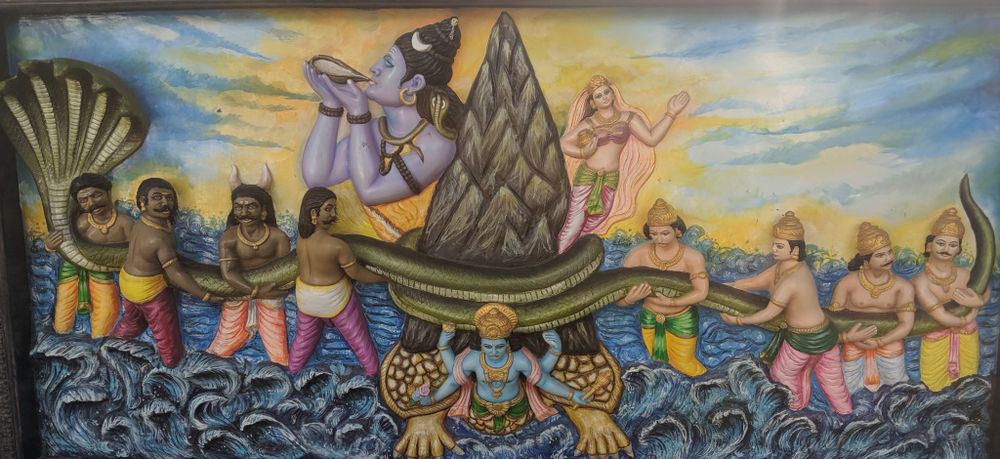
Samudra Manthan (Churning of the Ocean)
📅 23-May-2021
•⏱️4 min read
Samudra Manthan (Churning of the Ocean)
Devas (gods) and the Asuras (demons) churned the ocean under the aegis of Vishnu, to produce the divine elixir of ambrosia (Amrit).
Angkor Wat carvings depicts 88 asuras (demons) on the left, and 92 devas (gods), with crested helmets, churning up the sea to extract from it the elixir of ambrosia (Amrit).
The demons hold the head of the serpent "Vasuki" and the Gods hold its tail. At the centre of the sea, Vasuki is coiled around Mt Mandara, which turns and churns up the water in the tug of war between the demons and the gods.
Vishnu, incarnated as a huge turtle named "Kurma", lends his shell to serve as the base and pivot of Mt Mandara.
Legend behind Samudra Manthan
Once Indra, king of the devatas, while riding on an elephant came across sage Durvasa who offered him a special garland as a gift. To show he wasn’t egotistical, he placed the garland on the trunk of his elephant. The elephant was irritated by the smell and it threw the garland on the floor and trampled it. This enraged the sage as the garland was a dwelling of Sri (fortune) and was to be treated with respect. Durvasa Muni cursed Indra and the rest of the devas to lose their strength, power and immortality.
Post this incident, devas lost all the battles to asuras and the asuras gained control of the universe.
Devas sought help from God Vishnu who told them that the only way to get back their power is through consuming holy nectar which lies under the ocean. The holy nectar can be brought out only by churning the ocean. Since devas were bereft of any power they approached the asuras to jointly churn the ocean for the nectar of ambrosia.
NeelKantha
The first thing to be released by the ocean was a poison known as “Kalakootam” which could contaminate the ocean. God Shiva drank the poison to save others. However, Parvati – God Shiva’s wife squeezed his neck so that the poison does not get into his stomach. Thus, it stayed in his throat neither moving up nor going down and Shiva remained unharmed. The poison was so potent that it changed the color of God Shiva’s neck to blue. For this reason, God Shiva is also called Neelakantha where ‘Neela’ means blue and ‘Kantha’ means neck.
Samudra Manthan Ratna (Gems)
After this, the ocean released Ratna (gems) which vary in number depending on the text you read.
These include:
- Lakshmi, the Goddess of Fortune and Wealth – who accepted Vishnu as Her eternal consort.
- Apsaras, various divine nymphs like Rambha, Menaka, Punjisthala, Urvasi, Thilothamai, etc. – chose the demigods as their companions.
- Varuni or Sura, goddess and creator of alcohol – taken – somewhat reluctantly (she appeared dishevelled and argumentative) – accepted the demons.
Likewise, three types of supernatural animals appeared:
- Kamadhenu or Surabhi (Sanskrit:kāmadhuk), the wish-granting divine cow – taken by Vishnu, and given to sages so ghee from her milk could be used in sacrifices.
- Airavata, and several other elephants, taken by Indra, leader of the devas.
- Uchhaishravas, the divine 7-headed horse – given to the demons.
There were three valuables:
- Kaustubha, the most valuable jewel in the world, worn by God Vishnu.
- Parijat, the divine flowering tree with blossoms that never fade or wilt – taken to Indraloka by the devas.
- A powerful bow – symbolic of the demon’s belligerence.
Additionally produced were:
- Chandra, the moon which adorned Shiva’s head.
- Dhanvantari, the doctor of the gods with Amrita the nectar of immortality.
- Halahala, the poison swallowed by Shiva.
This list varies in different sources, few more Ratna are:
- Shankha Vishnu’s conch
- Jyestha – the goddess of misfortune
- the umbrella taken by Varuna
- the earrings given to Aditi, by her son Indra
- Kalpavriksha plant
- Nidra or sloth
The nectar released
Towards the end of the churning Dhanvantri ( god of medicine) appeared with the pot of holy nectar. Once the amrit was out, the demons forcefully took it away which was followed by a war between the devas and the asuras.
Garuda, the mount of Lord Vishnu, grabbed the nectar and tried to fly away with it. During this flight, it is believed that four drops fell to Earth – at Ujjain, Haridwar, Prayag (Allahabad) and Nasik. These four places are where the Kumbh Mela is celebrated every 12 years.
However, the demons chased Garuda and eventually got hold of the pot of nectar. To get it back, Lord Vishnu took the form of Mohini and distracted the demons while they were busy fighting amongst themselves over who would drink it first.
As Mohini, he reclaimed the nectar and started distributing it amongst the Devas. One of the demons, Rahu, disguised himself as a Deva and started to drink the nectar as well. Surya, the sun god noticed this and alerted Vishnu, who proceeded to decapitate the demon.
Rahu’s head is thought to have lived on, separate from his body, due to the immortality effect of the nectar.
The rejuvenated Devas proceeded to claim back their abode and defeat the demons.